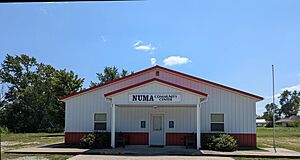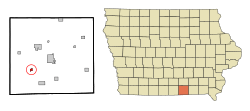Numa, Iowa facts for kids
Quick facts for kids
Numa, Iowa
|
|
|---|---|
|
City
|
|

The Numa, Iowa Community Center
|
|

Location of Numa, Iowa
|
|
| Country | USA |
| State | |
| County | Appanoose |
| Incorporated | November 9, 1909 |
| Area | |
| • Total | 0.44 sq mi (1.14 km2) |
| • Land | 0.44 sq mi (1.14 km2) |
| • Water | 0.00 sq mi (0.00 km2) |
| Elevation | 1,024 ft (312 m) |
| Population
(2020)
|
|
| • Total | 68 |
| • Density | 154.20/sq mi (59.53/km2) |
| Time zone | UTC-6 (Central (CST)) |
| • Summer (DST) | UTC-5 (CDT) |
| ZIP code |
52544
|
| Area code(s) | 641 |
| FIPS code | 19-57945 |
| GNIS feature ID | 2395280 |
Numa is a small city in Appanoose County, Iowa, in the United States. In 2020, about 68 people lived there. This number was lower than in 2000, when 109 people lived in Numa.
Contents
Where Numa Is
Numa is located in Appanoose County, Iowa. It covers a small area of land, about 0.44 square miles (1.14 square kilometers). All of this area is land, with no large bodies of water.
Numa's Past: A Coal Mining Town
Numa was first set up in 1871. It became an important place because of the coal mines nearby.
One of the biggest mines was the Numa Block mine. In 1907, a fire destroyed the equipment at this mine. The mine shaft was 150 feet (46 meters) deep. It reached a coal seam that was 30 inches (760 mm) thick. A coal seam is a layer of coal found underground.
The Numa Block Coal Company also owned mines in Seymour. In 1912, a workers' group called the United Mine Workers had 392 members in Numa.
The first Numa Block mine closed in 1915. It had mined coal from 240 acres (0.97 square kilometers) of land. In 1911, the company started a new mine about a mile east of Numa. This new mine employed 155 men. They dug up 300 tons of coal every day. This coal was then shipped out in 175 train carloads each month.
A new company town called Martinstown was built near this mine in 1913. A company town is a place where houses and services are owned by the company that employs most of the residents. The 40 houses in Martinstown were sometimes called Shantytown. This mine closed in 1937. Today, only the dark remains of the Martinstown slag pile are left. A slag pile is a heap of waste material from mining. In 1914, the Numa Block Coal Company produced over 100,000 tons of coal. This made it one of the top 24 coal producers in Iowa.
People in Numa
Numa's population has changed a lot over the years. In 1880, 122 people lived there. The population grew to 659 people in 1910, when coal mining was at its peak. Since then, the number of people living in Numa has slowly gone down. By 2020, only 68 people lived in the city.
Life in Numa in 2020
In 2020, there were 68 people living in Numa. These people lived in 37 households. Most residents were White. About 2.9% of the population was Hispanic or Latino.
About 10.3% of the people were under 20 years old. Many residents were older, with 29.4% being 65 years or older. The average age in Numa was 52 years. There were slightly more females (55.9%) than males (44.1%) living in the city.
Life in Numa in 2010
In 2010, Numa had 92 people living in 44 households. All of the residents were White.
About 15.2% of the people were under 18 years old. About 22.8% were 65 years or older. The average age in Numa was 47 years. In 2010, there were more males (55.4%) than females (44.6%) living in the city.
Education
Students in Numa attend public schools operated by the Centerville Community School District.
See also
 In Spanish: Numa (Iowa) para niños
In Spanish: Numa (Iowa) para niños


